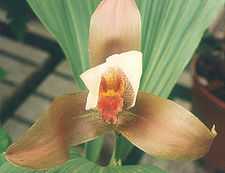Lycaste
| Lycaste | |
|---|---|
 | |
| Lycaste skinneri | |
| Scientific classification | |
| Kingdom: | Plantae |
| (unranked): | Angiosperms |
| (unranked): | Monocots |
| Order: | Asparagales |
| Family: | Orchidaceae |
| Subfamily: | Epidendroideae |
| Tribe: | Maxillarieae |
| Subtribe: | Lycastinae |
| Genus: | Lycaste Lindl., 1843 |
| Species | |
|
See text | |
| Synonyms | |
|
Deppia Raf. | |
Lycaste, abbreviated as Lyc in horticultural trade, is a genus of orchids that contains about 30 species with egg-shaped pseudobulbs and thin, plicate (pleated) leaves.
Description
Lycaste flowers, like all orchid blooms, have three petals and three sepals. The petals are typically yellow, white, or orange, and the sepals are yellow, orange, green, or reddish brown. The petals and sepals may be marked sparsely or densely with red, reddish purple, purple, or reddish brown spots. The lip (ventral petal) may be very similar to the other two petals, as in Lycaste aromatica or Lycaste brevispatha, or colored quite distinctively, as in several subspecies and varieties of Lycaste macrophylla. Most Lycaste flowers are medium in size, averaging about 5 to 10 cm, but Lyc. schilleriana is 16-18 cm across. Some Lycaste blooms have a unique fragrance - the scent of Lyc. aromatica has been variously described as cinnamon or clove. The blooms of the species Lyc. cochleata, consobrina, and cruenta also have a pleasant scent.
Taxonomy
The World Checklist of Selected Plant Families, maintained by the Royal Botanic Gardens at Kew, is recognized by the American Orchid Society as the definitive authority on orchid taxonomy. The Checklist currently acknowledges 31 species of Lycaste, 3 natural hybrids, 2 subspecies (and 1 nominate subspecies), and 1 variety. Orchid growers and orchid collectors, who tend to be taxonomic "splitters" more often than "lumpers" (see lumpers and splitters), recognize additional subspecies and varieties of Lycaste, as well as alba (white) forms of several species.
The Lycastes have been divided into four sections, one of which has two subsections:
- Section Deciduosae - deciduous, that is, they usually lose their leaves during an annual dormant period
- Subsection Xanthanthae - have yellow to orange blooms; the name is from xantho - yellow, and anthos - flower
- Subsection Paradeciduosae - have pink-marked white blooms; the name is from para- similar or near, and deciduosae- deciduous ones
- Section Longisepalae - has very long sepals
- Section Macrophyllae - keep their leaves during dormancy; the name is from macro- large and phyllae- leaves
- Section Fimbriatae - typically have fringed lips
All but two of the Deciduosae have spines at the apices of their pseudobulbs, that become exposed when the leaves are dropped - the exceptions are a Xanthanthae species, Lycaste lasioglossa, and a Paradeciduosae species, Lycaste tricolor. Both of these species lack spines, and may bloom when leaves are still present.

The recognized Xanthanthae species include:
- Lycaste aromatica,
- Lycaste bradeorum,
- Lycaste campbelli,
- Lycaste cochleata,
- Lycaste consobrina,
- Lycaste crinita,
- Lycaste cruenta,
- Lycaste deppei,
- Lycaste lasioglossa,
- Lycaste macrobulbon.
The Paradeciduosae species include:
- Lycaste brevispatha,
- Lycaste tricolor.
The Macrophyllae form a large complex, with subspecies and varieties that can be considered to be in the process of differentiating into new full species. The Macrophyllae species include:


- Lycaste dowiana,
- Lycaste leucantha,
- Lycaste macrophylla
- Lycaste macrophylla var. desboisiana
- Lycaste macrophylla subsp. macrophylla
- Lycaste macrophylla subsp. puntarenasensis
- Lycaste macrophylla subsp. xanthocheila
- Lycaste neglecta,
- Lycaste powellii,
- Lycaste skinneri,
- Lycaste xytriophora.
The Fimbriatae species include:
- Lycaste longipetala,
- Lycaste mesochlaena.
Natural hybrids :
- Lycaste × groganii (Lycaste aromatica × Lycaste deppei)
- Lycaste × michelii (Lycaste cochleata × Lycaste lasioglossa)
- Lycaste × smeeana (Lycaste deppei × Lycaste skinneri)
Hybrids
- Angulocaste (Anguloa x Lycaste)
- Cochlecaste (Cochleanthes x Lycaste)
- Colaste (Colax x Lycaste)
- Lycasteria (Bifrenaria x Lycaste)
- Lycida (Ida x Lycaste)
- Maxillacaste (Lycaste x Maxillaria)
- Zygocaste (Lycaste x Zygopetalum)
A recently published (2003) revision of Lycaste by Henry Oakeley and Angela Ryan split off most of the species of section Fimbriatae as the new genus Ida. The 34 species of Ida occur in South America or in the Caribbean Islands (Ida barringtoniae), while true Lycastes occur mostly in Mexico and Central America. The genus Ida is recognized by the World Checklist of Monocotyledons.
Notes
- Well-written web site by Phil Tomlinson on Lycastes and the closely related genus Anguloa; the Lycaste information is based largely on the 1970 monograph by Dr. J. A. Fowlie.
- WCSP (2011), World Checklist of Selected Plant Families, Royal Botanic Gardens, Kew, retrieved 2011-10-23, search for "Lycaste"
- Fowlie, J. A., 1970: The Genus Lycaste; privately printed
- Dr. Henry F. Oakeley, 1993 : Lycaste Species: The Essential Guide
- Dr. Henry F. Oakeley, 2008 : Lycaste, Ida and Anguloa: The Essential Guide
- A.F.W. (Fred) Alcorn and Michael S. Hallett, 1993. Lycaste orchids : cultivation and hybridisation
External links
| Wikimedia Commons has media related to Lycaste. |